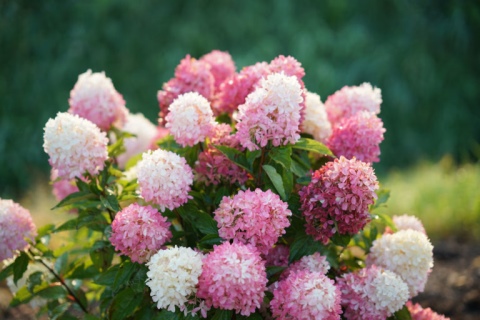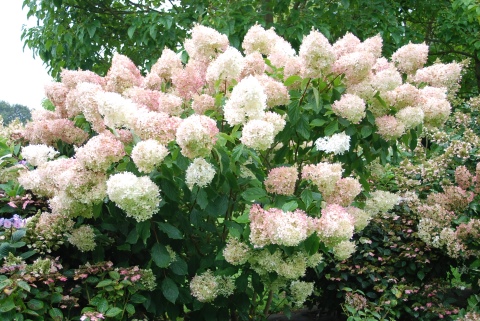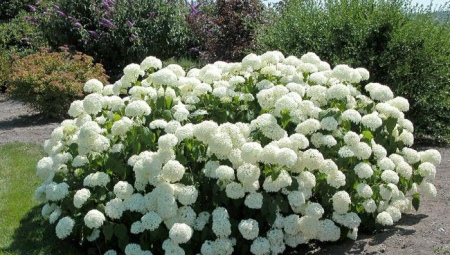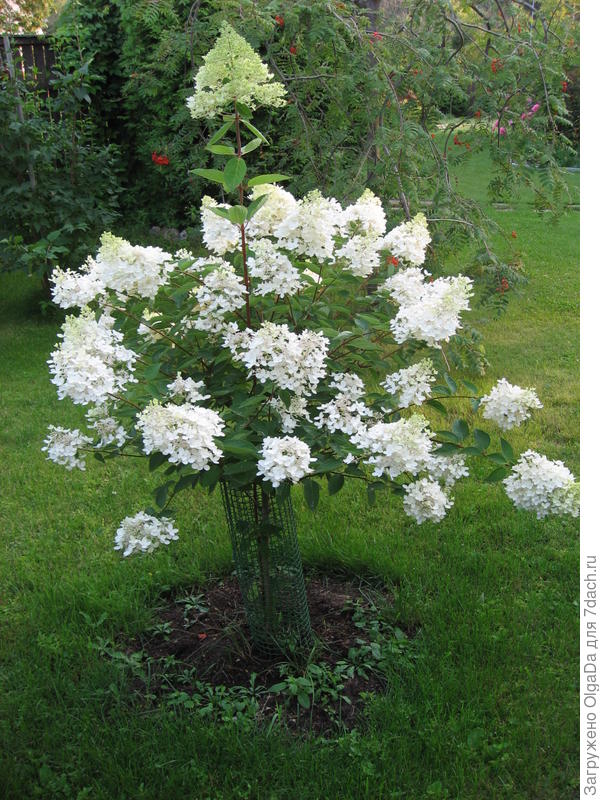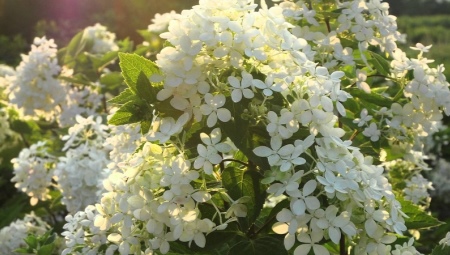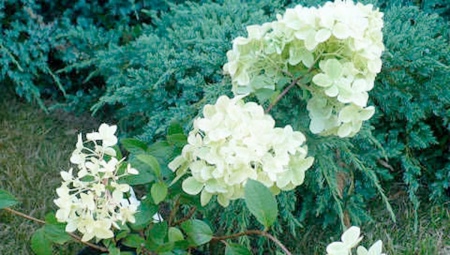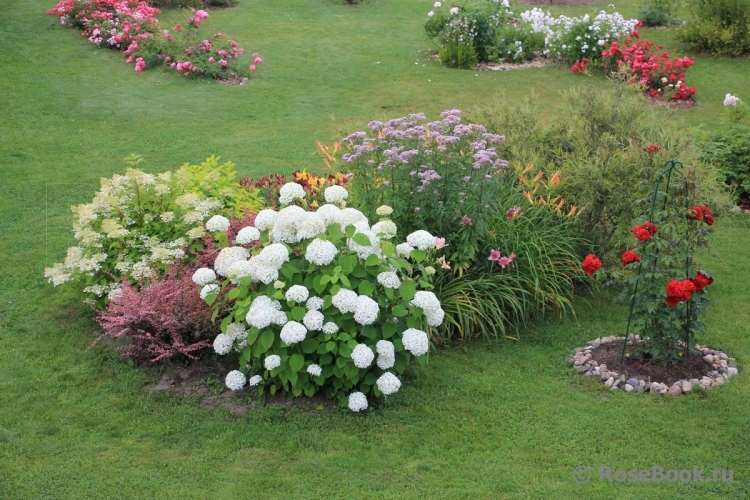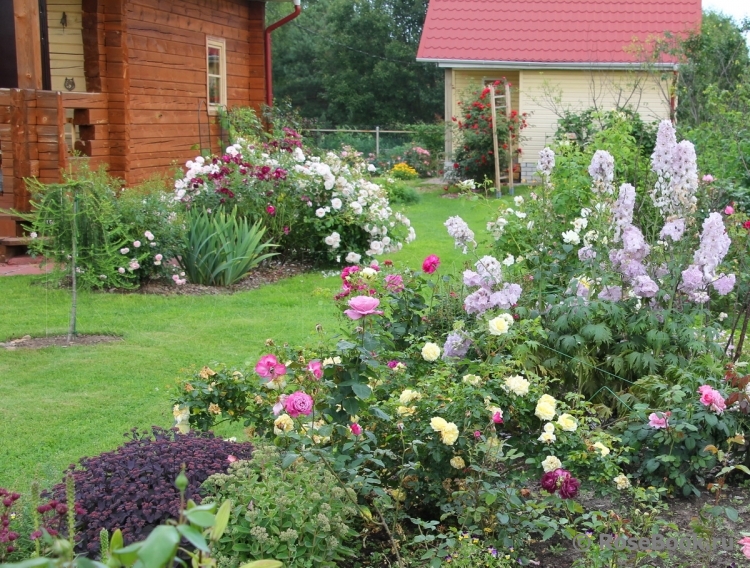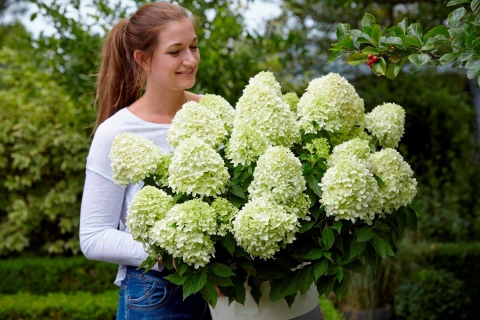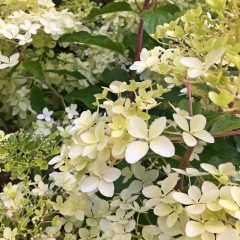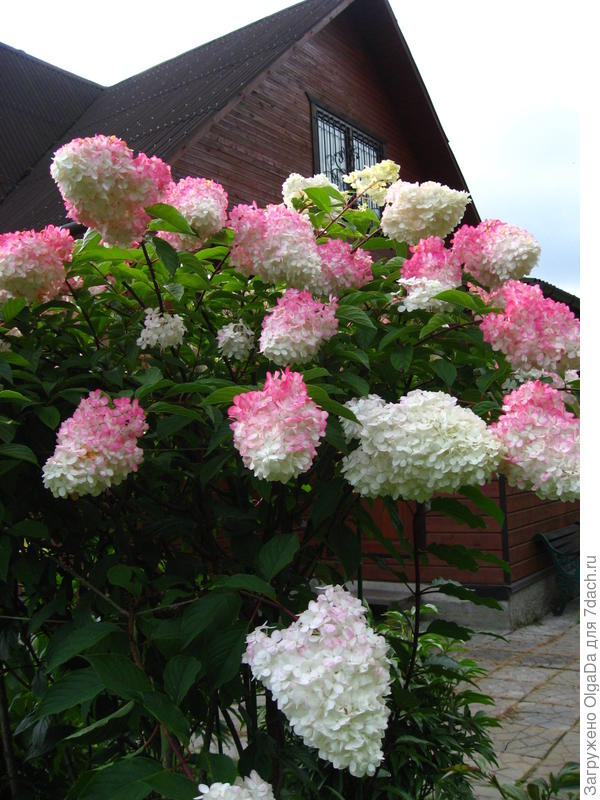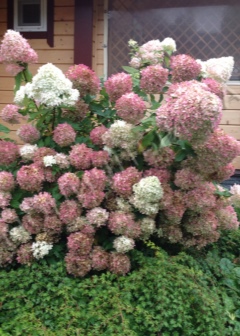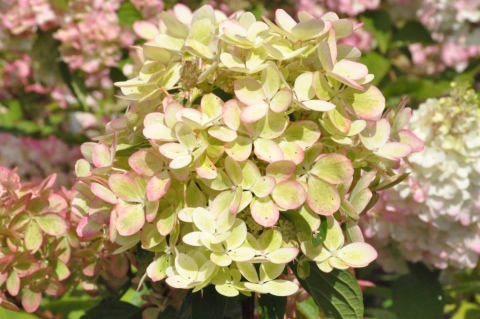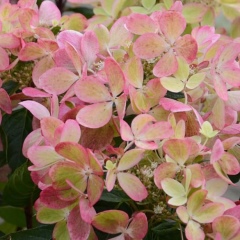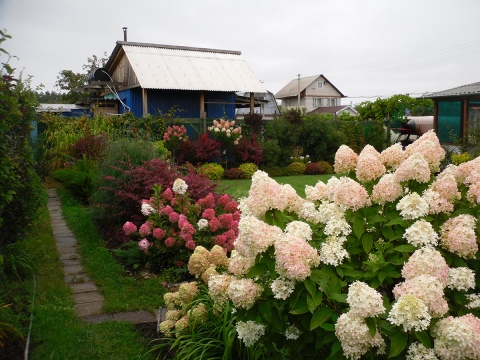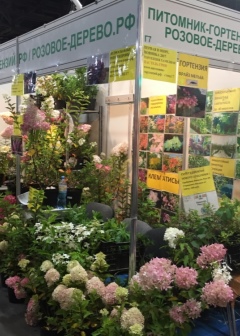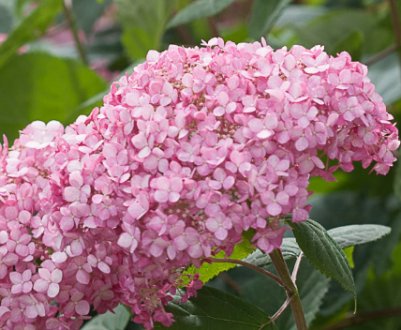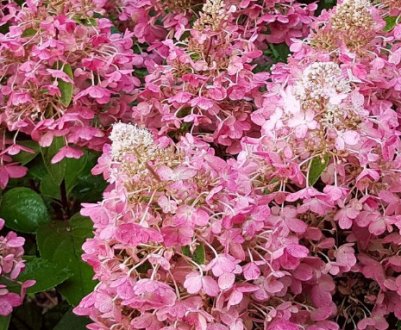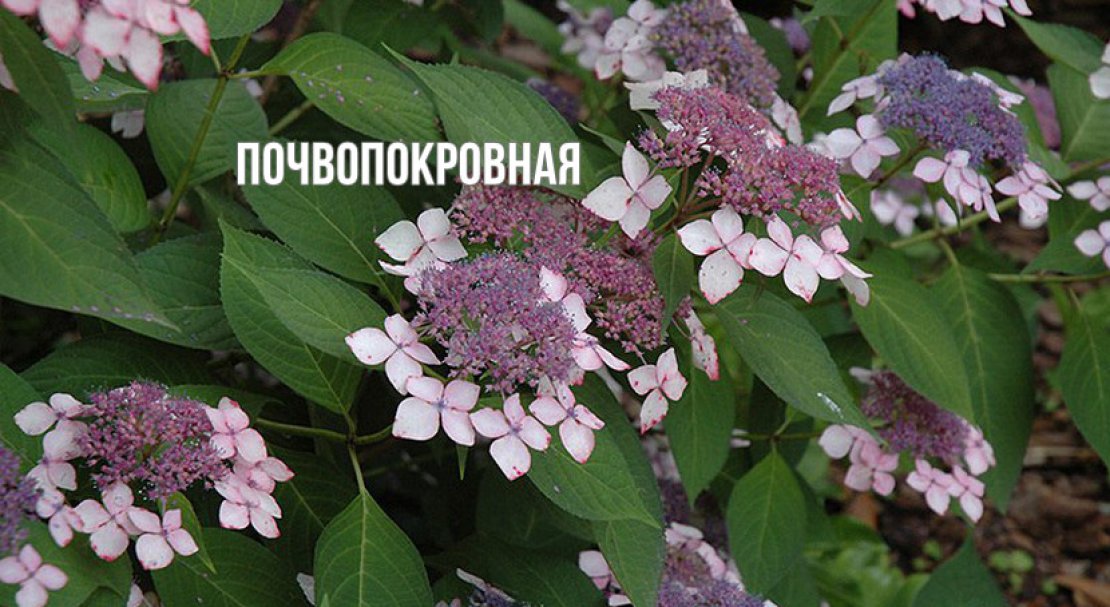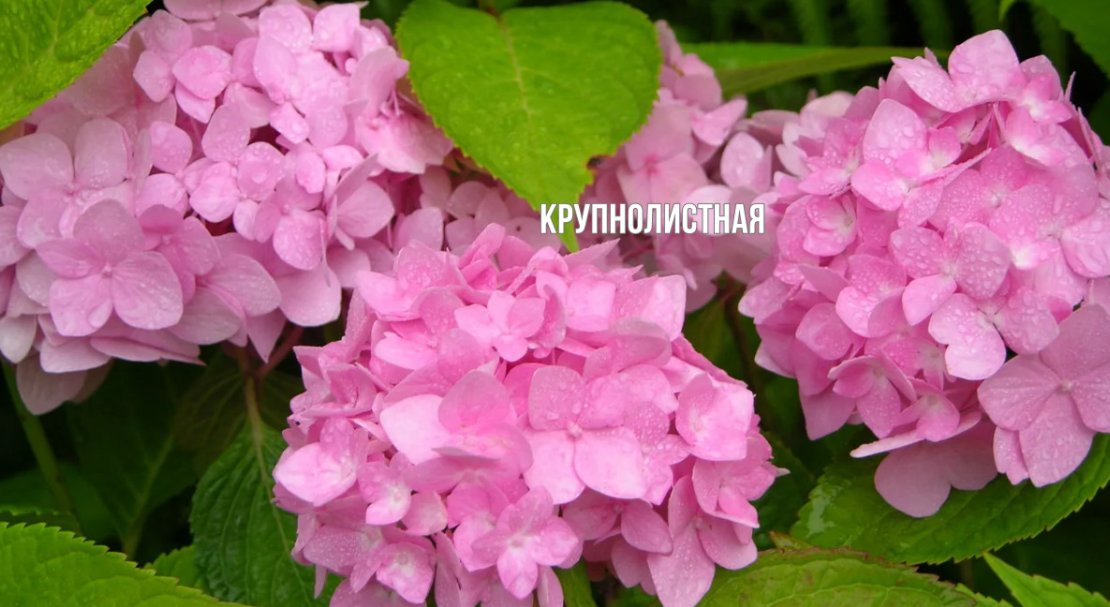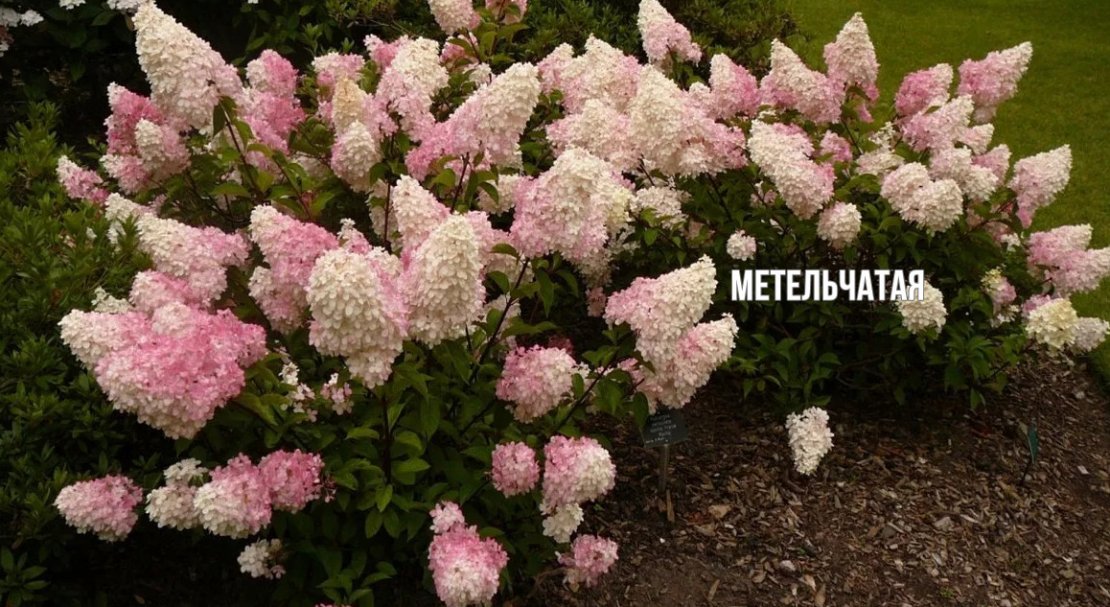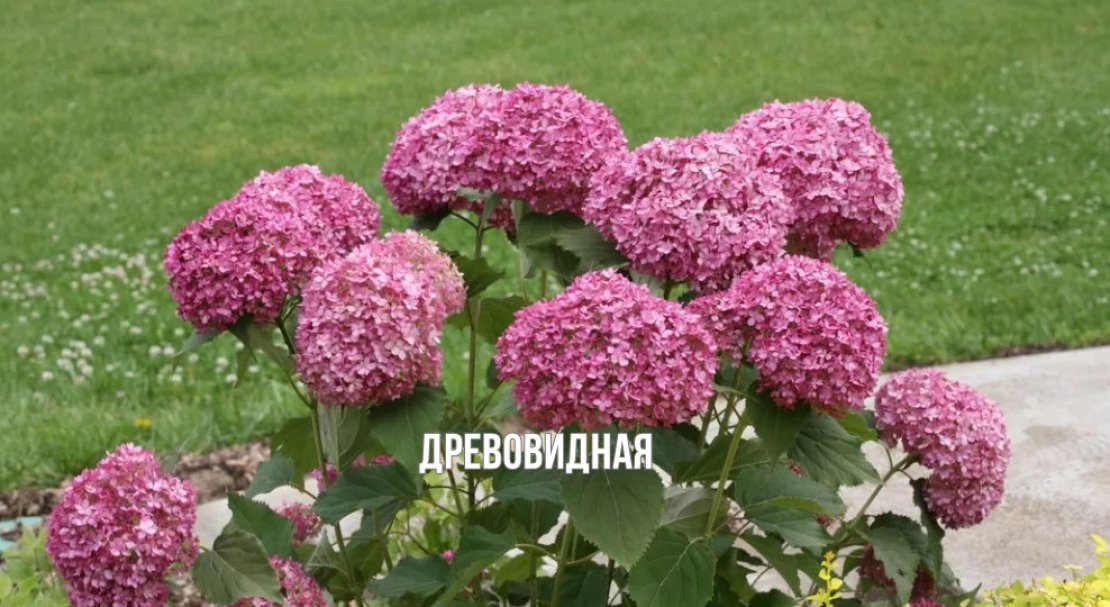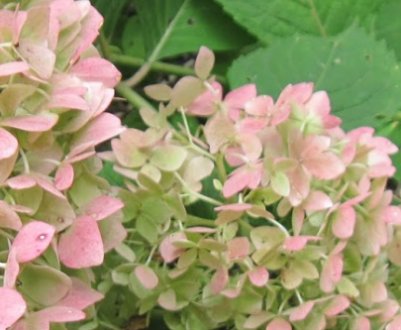Features and description of the plant
A distinctive feature of this variety of hydrangeas is the unusual color of the petals of the inflorescences. During the summer season, they can change their color several times. The color palette is quite extensive, so at the beginning of the season you can observe the white petals, and by the end you can see the petals of a pink or wine shade. When moving from one color to another, they gradually mix, which is similar to the palette of artists, and is breathtaking.
During the season, the color change occurs from 2 to 7 times.
Usually the first color is white, then it is replaced by creamy shades, after which there is a transition to a greenish palette to pistachio tones. Further, the flowers take on salmon colors. After that, there is a smooth transition to coral and pink, and closer to autumn and the end of flowering, there is a change to wine-bloody shades. If you choose the right time, you can find several shades on the inflorescences at once, and then the plant looks truly magical and fascinates with its beauty and uniqueness. This feature makes Pastel Green very popular.
Another plus of the plant can be considered its rapid growth, which allows you to enjoy flowering soon after planting.
The inflorescences of the plant are quite large, resemble a cone in shape, their length can reach up to 20 centimeters. The flowers are in the shape of a quatrefoil, and the leaves are blob-like and have the usual green hue.
The size of the shrub is compact: its height reaches 1.5 meters, and its width is 1.3 meters. Such a small size allows gardeners to plant this plant even in small gardens.
Another feature can be considered the fact that this variety can be grown in a large pot and placed on your balcony if you do not have a garden, and you really want to plant a plant.
Flowering usually begins in June and ends in September, but under favorable conditions and warm weather, bud formation can be observed until October.
The plant has large and airy inflorescences. In appearance, they can be compared to a "cloud" of cotton candy, since the plant blooms very luxuriantly.
When planting a flower, you should not worry too much about the fact that it is necessary to create any conditions for it, since it grows well in direct sunlight, while its petals remain saturated in color.
It is believed that hydrangea shrubs are unpretentious to care for, however, like any other plant, minimal care is necessary.
It is worth watering regularly, but it is necessary to monitor the moisture content of the soil to avoid waterlogging. For Pastel Green, the soil can be allowed to dry out. Therefore, if you planted it at a summer cottage, then you should not worry too much, since watering is also suitable for the shrub once a week. Water should be poured directly under the bush, as the accumulation of moisture on the leaves and inflorescences can harm the plant.
Do not forget about feeding the shrub. This procedure is usually performed in the fall and spring. For the autumn months (September and October), fertilizing with mineral fertilizers is characteristic; for the spring period, a urea solution in a ratio of 20 to 1 is better, that is, 20 grams of urea is enough for 1 bucket of water. For an adult shrub, approximately 20 liters of top dressing is needed. When the hydrangea blooms, it is worth applying complex mineral fertilizers 2 times a month.
Better to take a break of 15 days.
Mulching is worth doing because it inhibits the growth of various weeds and helps to retain moisture in the soil, which makes it possible to water the plant less often.It is worth doing mulching from sawdust, peat moss and chopped tree bark.
This panicle hydrangea perfectly tolerates negative temperatures down to -30 degrees, therefore it grows well in our climate. For this reason, the plant should not be covered for the winter period of time.
The variety is not very whimsical, so it can be planted in any soil, but it is still advisable to choose a fertile one - for example, soil saturated with humus is optimal.
Planting should be done based on the design of the garden, without fear of areas that will be exposed to sunlight. It is not recommended to plant in the shade.
However, if your beauty grows poorly, you should pay attention to the soil composition - it is better to choose an acidic soil. The shrub should be pruned every year. Shrub should be pruned every year.
The shrub should be pruned every year.
Care
It is believed that hydrangea shrubs are unpretentious to care for, however, like any other plant, minimal care is necessary.
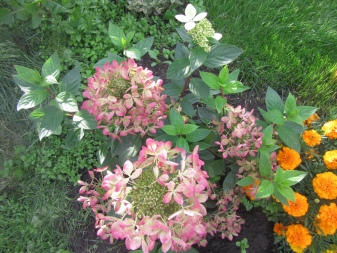
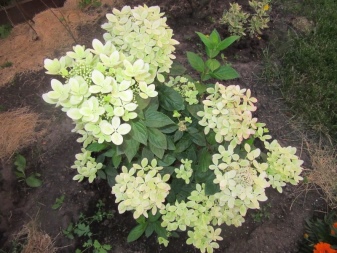
It is worth watering regularly, but it is necessary to monitor the moisture content of the soil to avoid waterlogging. For Pastel Green, the soil can be allowed to dry out. Therefore, if you planted it at a summer cottage, then you should not worry too much, since watering is also suitable for the shrub once a week. Water should be poured directly under the bush, as the accumulation of moisture on the leaves and inflorescences can harm the plant.
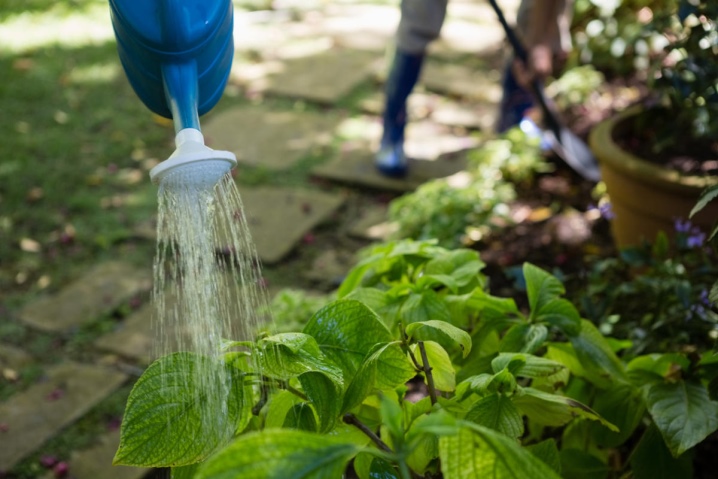
Do not forget about feeding the shrub. This procedure is usually performed in the fall and spring. For the autumn months (September and October), fertilizing with mineral fertilizers is characteristic; for the spring period, a urea solution in a ratio of 20 to 1 is better, that is, 20 grams of urea is enough for 1 bucket of water. For an adult shrub, approximately 20 liters of top dressing is needed. When the hydrangea blooms, it is worth applying complex mineral fertilizers 2 times a month.

Mulching is worth doing because it inhibits the growth of various weeds and helps to retain moisture in the soil, which makes it possible to water the plant less often. It is worth doing mulching from sawdust, peat moss and chopped tree bark.
This panicle hydrangea perfectly tolerates negative temperatures down to -30 degrees, therefore it grows well in our climate. For this reason, the plant should not be covered for the winter period of time.


The variety is not very whimsical, so it can be planted in any soil, but it is still advisable to choose a fertile one - for example, soil saturated with humus is optimal.
Planting should be done based on the design of the garden, without fear of areas that will be exposed to sunlight. It is not recommended to plant in the shade.
However, if your beauty grows poorly, you should pay attention to the soil composition - it is better to choose an acidic soil
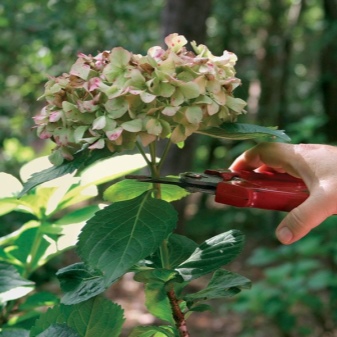
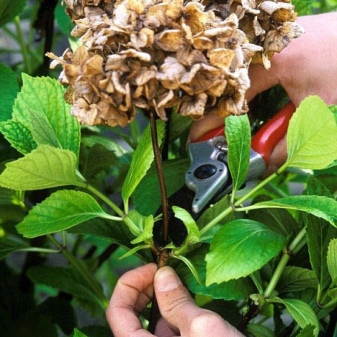
Description of the variety
Hydrangea "Grandiflora paniculata" is a paniculate plant variety, which is an ornamental shrub that is loved by many gardeners. It has the following botanical characteristics:
- the crown is spherical, up to 2-2.5 m in diameter, the shrub grows up to 2.5-3 m in height, often these indicators are the same;
- the roots of the plant are developed, spreading, growing to the sides, located in the surface soil layer;
- the leaves are large, oval in shape, their length is 10-12 cm, the surface is rough, covered with a small fluff;
- pyramidal inflorescences, which are panicles, are 20 cm long and include white flowers 3 cm in size, which can change their color to cream, pink, even greenish in combination with a dark red tint;
- the annual growth of hydrangea is 25 cm, it is for this length that its branches grow; The culture can fully bloom as early as 4 years after planting, depending on the region, this process takes place from the first days of June to September or from mid-summer to October.
Hydrangea Grandiflora is distinguished by its high winter hardiness. It can withstand severe frosts. In addition, the shrub has a certain resistance to various diseases.
Pruning hydrangea paniculata
Pruning hydrangea paniculata can be carried out in late autumn, after leaf fall, but better in spring, before the beginning of the growing season.
Formative pruning is necessary for young plants.If the plant is small and consists of 2-3 short twigs, sparingly cut them in the fall at a height of 20-25 cm to good buds to stimulate tillering. Larger seedlings are shortened by a third, weak and damaged shoots are removed. The goal of formative pruning is to get more strong shoots.
Nursery-acquired container plants are often larger, more mature, and already have several stems. They, like the plants that have already grown in the garden, are subjected to the usual pruning in the spring. It consists in shortening the shoots to a pair of strong buds that are capable of producing good inflorescences on the growths of the current year; at first, a quarter or a third of the length of the shoots has to be cut. Also, too long and thin shoots are cut off, rubbing and growing inward crowns, frozen over, are removed. This pruning should be done annually. With age, you will still have to cut out too old shoots so that they are replaced in time by young shoots.
Here it is worth touching on the issue of pruning faded inflorescences. They often write that dry inflorescences look decorative in winter, in hoarfrost and snow caps, so it is better to cut them off in spring. In my opinion, pruning of inflorescences is still best done in the fall, especially for older varieties with thin stems. In heavy snowfall, freezing rain branches can break off. The risk of breaking by snow especially increases if the bush was formed into one trunk and resembles a standard tree in appearance. It is necessary to strive for a multi-stemmed habit. Only the caps of the inflorescences are cut off, the main pruning is carried out in the spring, leaving 3-5 strong buds on annual growths.
Stamp forms, which are offered by nurseries, in youth and, especially, in winter, should be tied to the support. They do not need to leave a wide crown, cutting off the shoots to strong buds and rounding the shape.
If you neglect pruning, over the years the bark on the old stems of hydrangea cracks, the crown thickens with irregular weak shoots, the bottom of the bush is bare and the inflorescences are only at the top. And the intensity of flowering itself decreases.
But everything is fixable. Hydrangea paniculata tolerates strong anti-aging pruning, even on a stump, to a height of 10-15 cm from ground level. She is durable, 30 years is not age for her, she is quite capable of living twice as long.
Spring pruning must be combined with top dressing. It is most convenient in early spring, without delay, to apply long-acting granular fertilizer under mulch, then you will not have to worry about summer dressing.
How to take care of it properly?
Healthy, planted according to all the rules, bushes grow and develop rapidly, annually adding 30-40 cm in height and width. With such indicators, there is no doubt about the future rapid flowering of the shrub, but this should be preceded by proper care.
Moisturizing and watering
A sufficient amount of moisture ensures high-quality formation of flowers; the soil should not be allowed to dry out. In extreme heat, watering is carried out once a week; for an adult shrub, at least 2 buckets of water are required
Young bushes are watered carefully, checking the dryness of the soil to a depth of 15-20 cm.In cool weather, the volume of water is halved
Top dressing
The rapid development of the aboveground part during the growing season is due to the fact that the plant consumes a large amount of nutrients, therefore additional soil fertilization is necessary. For this, mineral compounds and organic additives are used - humus and rotted sheet compost, 4 times a year. It is mandatory to feed during the appearance of buds, buds, in mid-July and after the culture fades in autumn to support the depleted plant.
During the first application of fertilizers, it is allowed to use poultry droppings or manure infused for 24 hours. Each bush requires 12 liters of liquid solution.When buds are formed, potassium salt, saltpeter and superphosphate will be needed for active flowering. In the summer, complex fertilizers for hydrangeas are required, in the fall, potassium salt and any products containing phosphorus are again used.
Loosening and mulching
Loosening is a mandatory and regular procedure. It is carried out after irrigation and, if necessary, throughout the entire time until the next irrigation to a depth of at least 10 cm, along with weeding. Mulching the surface near the trunk is necessary to maintain moisture, which is important for the summer season. The layer is made up to 30 cm thick from dry wood chips, peat, leaves and humus.
Pruning
The panicle variety "Grandiflora" must be cut periodically in the spring, before sap flow begins, cutting off old and weak branches, as well as shoots with damaged bark. Old specimens need to be rejuvenated, for this their branches are shortened. Mature branches are cut into 2-3 buds.
Preparing for the winter period
Protecting the plant during cold weather does not imply the construction of a shelter, and during a snowy winter, the snow mass saves the culture from freezing. It is enough to pour a thick layer of mulch under the shrub to protect the roots - fallen leaves and humus are used as material. "Grandiflora" well tolerates sub-zero temperatures down to -30 degrees, but young seedlings must be protected during the first 2 years, so it is better to cover them with any non-woven cloth, on top of which a snowdrift forms when snow falls.

